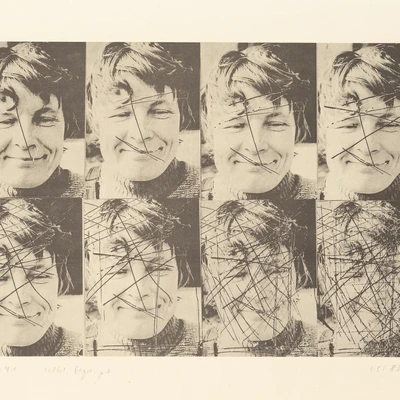Edmund Kesting
- * 1892
- † 1970
Life dates
- Artist
Category
The Restless Experimenter
Edmund Kesting, born 1892 in Dresden, began studying painting and sculpture in 1911 at the Kunstgewerbeschule Dresden and then moved to the Akademie der bildenden Künste in 1915. In the wake of the First World War, many artists felt that celebrating the freedom of forms and colors offered them the only possible path of escape from the unreal reality they faced. Edmund Kesting, too, who was stationed as a soldier in Ardennes from 1915 to 1918, was in search of new forms of artistic expression. His experience of the exhibition mounted in Dresden (1919) on the Berlin artist group in the circle of Herwarth Walden and Der Sturm – and his meeting of Walden (1921) as well as artists like Vassily Kandinsky, Kurt Schwitters, Alexander Archipenko and Marc Chagall – helped him find his way.
In works that one could call constructions on paper, Kesting – who was a masters fellow of Otto Gussmann just after World War I – plunges us into a fireworks of color with explosive temerity. In the 1925 oil painting Einsames Haus (Lonely House), he constructs buildings and their landscapes with lines and geometric forms in contrasting colors. In these “Picture Constructions” of the 1920s – comprising objects, assemblages, cut-out collages or interlocking canvases – Kesting explores a wide array of materials and creates a tension between freedom and discipline his composition.
Starting in the mid-1920s, Kesting’s impact widened – he was well connected in the international art scene and his works were included in many exhibitions. When Neue Sachlichkeit (New Objectivity) began to establish itself and representational painting underwent a renaissance, Kesting, too, ca. 1927, abandoned his constructivist phase and increasingly included another medium in his work: Inspired by artists such as László Moholy-Nagy and Oskar Nerlinger, he began an intensive exploration of photography. Here, too, work involving multiple exposures, photograms, and the splicing of negatives testifies to his joy in experimentation and his search for new solutions to the problems of the image. Soon, masterful portraits and dynamic dance scenes became the central motifs of his photographic output.
While still a university student, Kesting founded in 1919 in Dresden the private art school Der Weg – Schule für Gestaltung, which added another branch, in Berlin, from 1926 on. In 1933, both these schools were shut down by the National Socialists and Kesting had his home searched for the first time. In consequence, he destroyed some of his “picture constructions”. He was evicted from his atelier and took refuge, as it were, from political pressures and political co-option by concentrating on scientific and architectural photography. He earned his living as a commercial photographer, documenting the city of Dresden and the collection of the Grünes Gewölbe. In 1936, nevertheless, Kesting was prohibited from painting and exhibiting; in 1937, twelve of his works were classified as “degenerate art” and removed from German museums.
In those dark years, he sought a symbiosis of photography and painting and developed the technique of so-called “chemical painting”, in which he experimented with acids and ink on light-sensitive paper. His Üppige Vegetation (Abundant Greenery) from 1941 is an example of this kind of experiment. It stands in stark contrast to pictures from the pre-war years and anticipates the development of informal painting in post-war Europe.
In 1945, Kesting was the moving force behind the artist group Der Ruf – befreite Kunst (The Call – Liberated Art, active through ca. 1948), which sought to reconcile the artistic Avant-Garde with Socialist politics. Starting in 1946, he led the workshop for photography and film at the Dresden Akademie für Werkkunst; and, when he was dismissed from that post in 1948, took over the class in photography at the Hochschule für Bildende und Angewandte Kunst in Berlin-Weissensee. In 1953, he was dismissed once again as a result of the so-called “formalism debate”. From 1955 to 1960, he worked at the Hochschule für Film und Fernsehen in Potsdam-Babelsberg; and in 1958, he published his book Ein Maler sieht durch’s Objektiv (A Painter Looks through the Camera Lens). When Edmund Kesting died in 1970 in Birkenwerder, he left behind an extensive and multifarious oeuvre, reflecting many important aspects of the avant-garde movements of the 20th century, in both art and photography.
text: Anke Paula Böttcher, translation: Darrell Wilkins
Works by Edmund Kesting
Travelling exhibition
Publik machen: 40 Künstler:innen aus dem Bestand des Zentrums für Kunstausstellungen der DDR
Popular keywords
Many more works are hidden behind these terms
